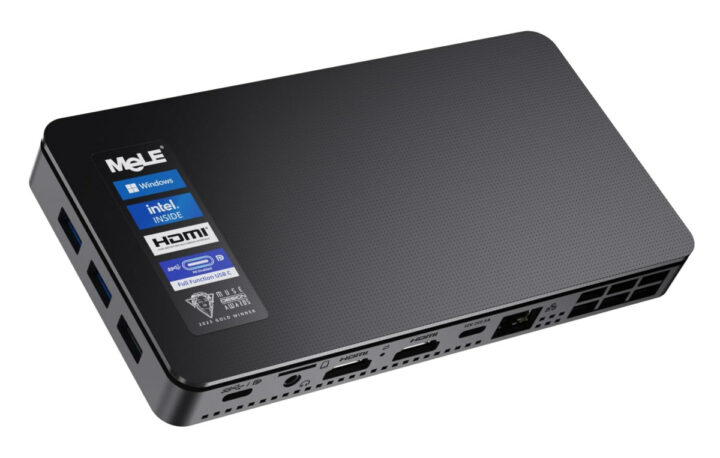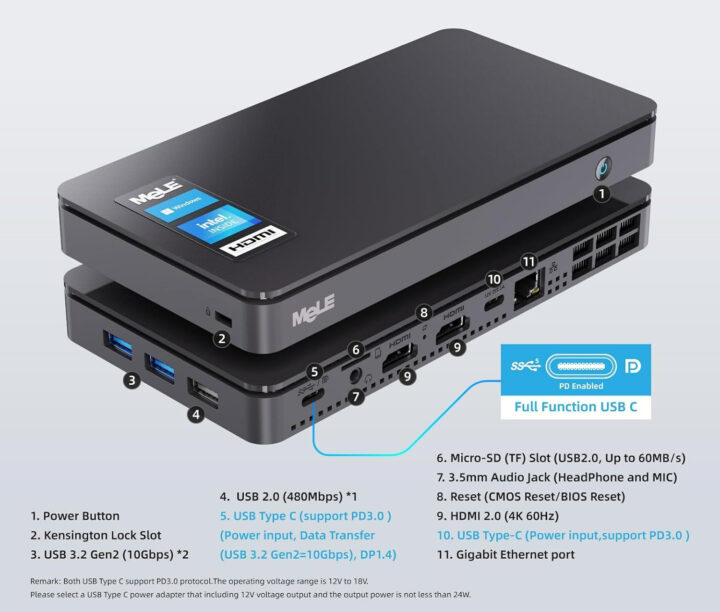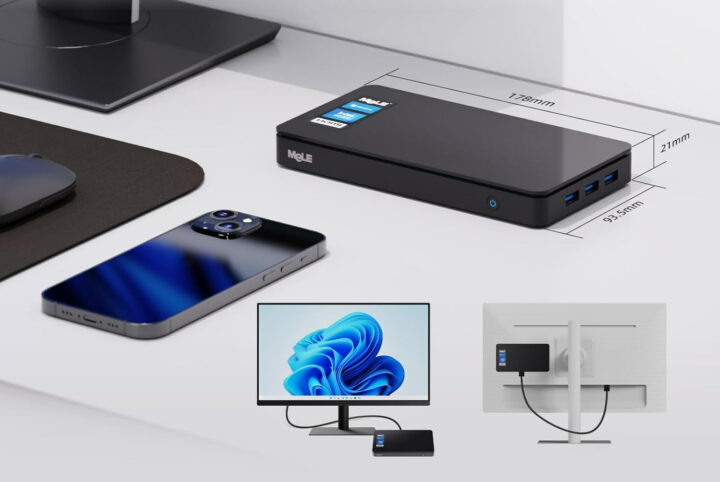Mele Overclock4C is an Intel Processor N95 Alder Lake-N mini PC with an ultrathin (21mm) design which, as its name implies, supports “overclocking”, although what it really means here is the ability to increase the PL1 and PL2 power limits in the BIOS/UEFI in order to increase performance without actually changing the top frequency of the processor…
It’s the same idea and virtually the same design as the MeLE Overclock3C which boosts the TDP of the Celeron N5095 Jasper Lake processor up to 18W instead of the 15W default. Here the TDP of the Processor N95 is likely boosted up to 20 Watts (as per Intel Ark) delivering a 33% performance improvement over the Celeron N5095. The Overclock4C is available with 16GB or 32GB DDR4, a 256GB eMMC flash, and a 256GB SSD.
MeLE Overclock4C specifications:
- SoC – Intel Processor N95 quad-core Alder Lake N-series processor @ up to 3.4 GHz (Turbo) with 6MB cache, 16EU Intel HD graphics @ 1.2 GHz; TDP: 15W; TDP up: 20W
- System Memory – 16GB or 32GB single-channel DDR4
- Storage
- 256GB eMMC flash
- M.2 NVMe 2280 socket fitted with 256GB SSD (512GB storage in total). The socket supports both SATA and NVMe drives.
- MicroSD card slot
- Video Output
- 2x HDMI 2.0 ports up to 4Kp60
- DisplayPort 1.4 Alt mode via USB-C port up to 4Kp60
- Support for up to three independent displays
- Audio – 3.5mm audio (headphone & microphone) jack, digital audio via HDMI
- Connectivity
- Gigabit Ethernet RJ45 port
- Dual-band 802.11 b/g/n/ac WiFi 6 and Bluetooth 5.2
- USB – 2x USB 3.2 Gen 2 ports (10Gbps), 1x USB 2.0 port, 1x USB 3.2 Gen 2 Type-C port (10 Gbps) with support for DisplayPort Alt mode and USB PD 3.0
- Misc
- Power button
- BIOS/CMOS Reset pinhole
- Kensington lock slot
- Internal cooling fan and pure copper heat pipe heatsink with 20W capacity
- BIOS features – Auto power on, Wake on LAN (WoL), RTC Wake up, PXE, BIOS reset
- Power Supply – 12V/3A via USB-C port, compatible with USB PD 3.0 (more details below)
- Dimensions – 178 x 93.5 x 21 mm
- Weight – About 320 grams
The mini PC comes pre-loaded with Windows 11 Pro using a permanent OEM key (as usual nowadays), but should also work with recent versions of Linux provided there aren’t any driver issues. We’ve seen plenty of mini PCs with 12V input from a (non-standard) USB-C adapter, and the MeLE Overclock4C does come with a 12V DC USB-C adapter, however the company also claims the two USB-C ports on the mini PC are USB PD 3.0 compliant with support for 12V and 18V only, which I understand as 5V not being supported. This should mean the device should work with any USB PD adapters delivering at least 36W.
MeLE is currently selling the Overclock4C (16GB RAM) ultrathin pocket-sized mini PC on Amazon for $219.99 provided you don’t forget to tick the $50 coupon option before adding it to the cart, and the 32GB RAM model goes for $279.99. Both variants should eventually show up on MeLE’s Aliexpress shop as well, but right now, only the older Celeron N5095 model is available.
Via Liliputing and AndroidTVBox.eu

Jean-Luc started CNX Software in 2010 as a part-time endeavor, before quitting his job as a software engineering manager, and starting to write daily news, and reviews full time later in 2011.
Support CNX Software! Donate via cryptocurrencies, become a Patron on Patreon, or purchase goods on Amazon or Aliexpress








N95 has about 30% higher scores on Passmark than N5095, with its max turbo clock 17% higher (3.4 GHz vs. 2.9 GHz).
It’s probably not necessary to “overclock” that but eh whatever.
I do tend to like what Mele have done to bring the mini PC down to a really small size, whilst still packing in decent I/O.
Looking at the port breakdown, they give you the precise information that you need to remove guesswork and ambiguity. No typical ‘USB 3.0’ labelling with no indication of exactly which variety.
I also admire that when mentioning the Micro-SD card slot, they don’t hide what may potentially be seen as a tad slower than perhaps desired.
I am in two minds about splitting the storage between slow EMMC and infinitely faster M.2, although some may see more storage devices as adding to multi boot versatility.
The big question comes down to the price though, especially with their choice of using the N95, which like the N5095 and N5105 may well have vast stocks needing to be cleared, instead of going for what seems to be the wildly popular and capable N100.
Other vendors are offering N100 boxes at very keen prices, and although, overall, they will not have the complete range of options available here, are still likely to sway purchasers more.
With having options to buy through the likes of Amazon, import fees can essentially be mitigated, along with the easy return policies, that will have some added value.
But I can’t help but feel that despite the great overall specs offered here, will the sight of N95 be an instant put off for many.
Perhaps the overclock option is an attempt to bridge the gap between the N95 and N100 performance, which begs an obvious thought, a CNX test to find out?
We have tested the Overclock4C, but in our tests with other mini PCs, the N100 is slightly faster than the N95. However, I don’t think most users would notice. You’ll find a comparison table in the review: https://www.cnx-software.com/2023/08/30/blackview-mp80-review-part-2-an-intel-processor-n95-mini-pc-tested-with-windows-11/#intel-processor-n95-vs-processor-n100
Note that multi-core tests especially, the cooling ability of the mini PC must be taken into account.
It would be nice if they stopped making power supplies that deliver 12V by default and that seem to be purposely designed to fry all other hardware around… At least this machine supports full USB-PD so they should be able to use any USB-compliant PSU with it.
They could even sell it with an option to have one of the new GaN PSUs. For such a device, they’d be quite small, not much expensive and would barely heat, it would likely interest buyers, instead of living with the fear that a wandering USB-C cable on their desk might be plugged into a phone or tablet and make them release the final smoke.
I like this a lot, simply because a Thunderbolt dock with this feature set cost more than this minipc 2 years ago. Also the N95 seems to outperform the N100 in most published tests.
Willy says this has a dumb 12V USB-C power supply, which will therefore blow up any device with a USB-C port that doesn’t support PD. That’s could be scary if you have careless co-habitants and/or didn’t put a piece of red masking tape on it marked 12V ONLY!
I would be interested in seeing the public tests that you have seen where the N95 had come up against the N100 as I’ve not yet seen any that show the N95 to outperforming the N100.
I’ve seen certain instances where things were closer than expected but no clear indication of the results that you have seen.
I did see some yesterday on one of those numerous “X vs Y” sites showing geekbench results, but I don’t remember which one. It seems its GPU is less capable, so possibly it reaches the throttling level later and can overall deliver more CPU work in a similar thermal envelope. That’s just a guess.
> That’s could be scary if you have careless co-habitants and/or didn’t put a piece of red masking tape on it marked 12V ONLY!
That’s exactly what I did in the meeting room at work!
it working with haiku?